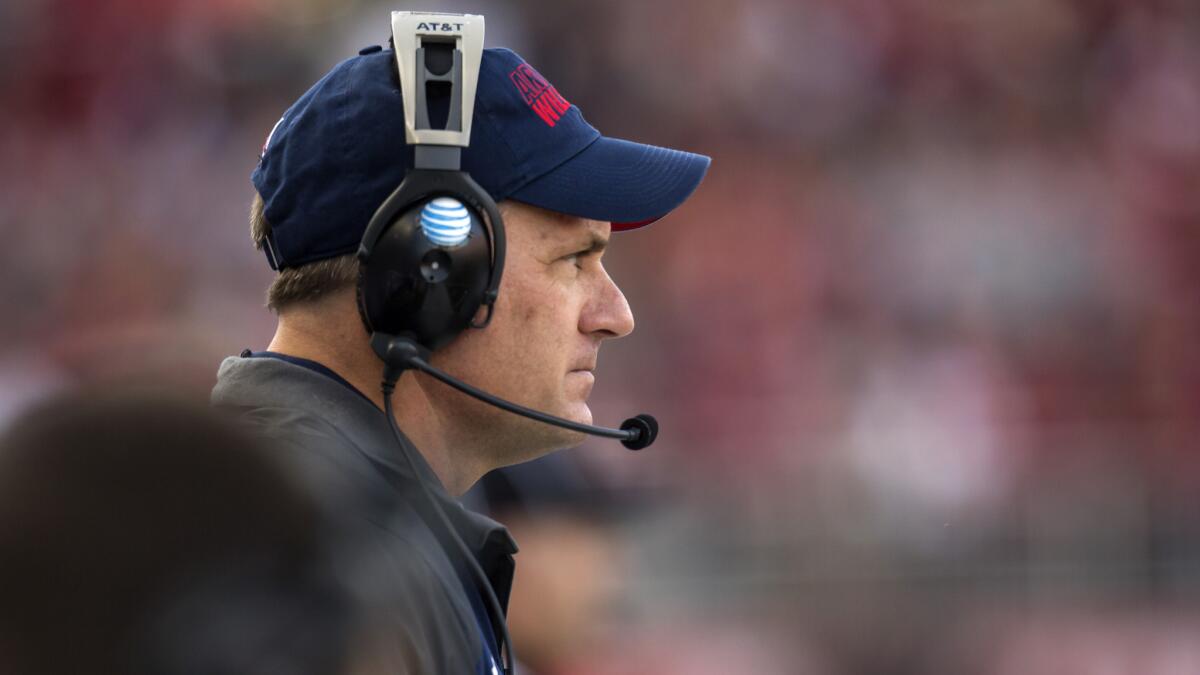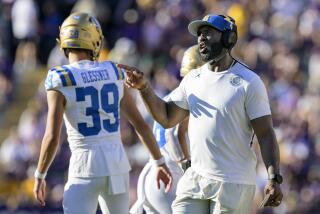UCLA, Arizona to meet in battle of offensive powerhouses

- Share via
A college football circus came to the New Orleans Superdome in 1997, when Mississippi took on Tulane.
The offenses, orchestrated by coordinators Noel Mazzone and Rich Rodriguez, made for a wild, heart-in-throat day.
Mississippi won, 41-24.
“Yeah, that was a shootout back then,” said Mazzone, who is now UCLA’s offensive coordinator. “That would be like a defensive battle today.”
Mazzone and Rodriguez, older and wiser, cross paths again Saturday night at the Rose Bowl, when UCLA faces Arizona in a key Pac-12 Conference game. Rodriguez is Arizona’s head coach, and a 41-24 halftime score is possible.
UCLA, 6-2 overall, 3-2 in conference play, has a potent offense that averages 35.7 points per game. But compared to Arizona, the No. 22 Bruins can look slow.
The No. 12 Wildcats, 6-1 overall, 3-1 in the Pac-12, are sixth nationally in total offense, averaging 541.9 yards per game, and 13th in scoring offense, averaging 40.6 points.
“We can’t have lapses against them or we’re going to be very, very embarrassed with the score at the end,” UCLA linebacker Myles Jack said.
The proliferation in offense the past decade was not entirely a Rodriguez creation, but he was a founding father. Credit or curse him — depending on your football philosophy — scoreboards around the nation now suffer from dead pixel syndrome.
“He’s changed offensive football; he’s changed defensive football,” UCLA Coach Jim Mora said. “He completely obliterated the meaning of statistics. You don’t even want to look at defensive statistics when you play a spread team.”
Rodriguez wasn’t the first coach to employ a spread offense, but he fine-tuned it, first as a coordinator at Tulane and Clemson and then as head coach at West Virginia. His offense flopped in three years as the head coach at Michigan, where fans were rooted in three-yards-and-a-cloud-of-dust tactics, but now several Big Ten teams use similar schemes.
In 1997, Rodriguez’s first year as an offensive coordinator, 32 major college teams averaged 30 or more points per game. That number is 68 this season, with three others at 29.9.
Rodriguez has mixed feelings about the growth of the spread.
“I don’t know if ‘satisfaction’ is the word,” he said. “It’s intriguing because 10 years ago, 15 years ago, it was rare. It was kind of neat to be rare. I enjoyed being unique.”
UCLA quarterback Brett Hundley said he wanted to take a peek at the Arizona offense’s tape this week, because “Rich Rod invented the spread.”
Rodriguez noted that while the spread has become a generic term, like snowflakes and prom dresses, no two are alike.
“It’s not, you’ve seen one spread, you’ve seen them all …” Rodriguez said. “The quarterback is in the shotgun, but everyone’s method of attack is different.”
Rodriguez’s method was revolutionary. He spread the field and ran the ball. Arizona averages 193.4 yards rushing per game.
“He opened a lot of eyes to how you run the ball out of the spread,” Mazzone said. “It was not just ‘run to the right,’ or ‘run to the left.’”
Mazzone had his own philosophies, but said that seeing Rodriguez’s shtick “validated what we were doing.”
It also causes nightmares for defenses.
“When I got here 2 1/2 years ago, I had studied the landscape of college football and where it was going,” Mora said. “I knew we needed [defensive] players standing up so they could run. The field gets so big so fast.”
Rodriguez, Mora said, “uses every inch” of a field, which also made coaches re-think recruiting.
“You have to have athletes who move well and tackle in space,” Mora said.
Whichever of these mirror-image teams does that best will have the advantage Saturday night.
Twitter: @cfosterlatimes
More to Read
Go beyond the scoreboard
Get the latest on L.A.'s teams in the daily Sports Report newsletter.
You may occasionally receive promotional content from the Los Angeles Times.







